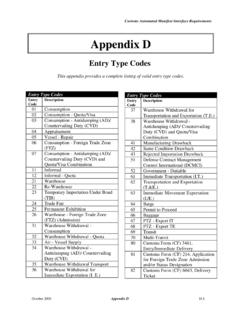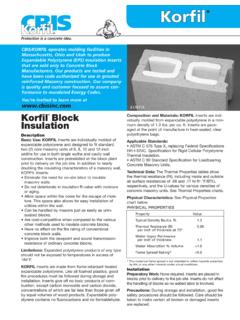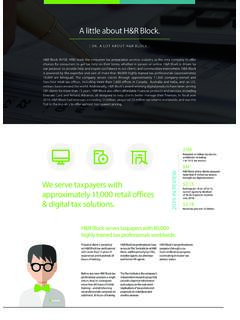Transcription of CBP FORM 7501 INSTRUCTIONS BLOCK 1) ENTRY …
1 DEPARTMENT OF HOMELAND Customs and Border ProtectionCBP form 7501 INSTRUCTIONSBLOCK 1) ENTRY NUMBERR ecord the 11 digit alphanumeric code. The ENTRY number is comprised of the threedigit filer code, followed by the seven digit ENTRY number , and completed with the onedigit check Filer Code represents the three-character alphanumeric filer code assigned to thefiler or importer by CBP. ENTRY number represents the seven-digit number assigned by the filer. The numbermay be assigned in any manner convenient, provided that the same number is notassigned to more than one CBP form 7501. Leading zeros must be shown. Check Digit is computed on the previous 10 characters. The formula for calculating thecheck digit can be found in Appendix 2) ENTRY TYPE Record the appropriate ENTRY type code by selecting the two-digit code for the type ofentry summary being filed. The first digit of the code identifies the general category ofthe ENTRY ( , consumption = 0, informal = 1, warehouse = 2).
2 The second digit furtherdefines the specific processing type within the ENTRY category. The following codesshall be used:Consumption EntriesFree and Dutiable01 Quota/Visa02 Antidumping/Countervailing Duty (AD/CVD)03 Appraisement04 Vessel Repair05 Foreign Trade Zone Consumption06 Quota/Visa and AD/CVD combinations07 Duty Deferral 08 Informal EntriesFree and Dutiable11 Quota Other than textiles12 Warehouse EntriesWarehouse21 Re-Warehouse22 Temporary Importation Bond23 Trade Fair24 Page 1 Permanent Exhibition25 Foreign Trade Zone Admission26 Warehouse Withdrawal For Consumption31 Quota/Visa32 AD/CVD34 Quota/Visa and AD/CVD combinations38 Government EntriesDefense Contract Management Command (DCMAO NY) Military Only (P99 filer) 51 Any Federal Government agency (other than DCMAO NY)52 Note:When the importer of record of emergency war materials is not a government agency, entrytype codes 01, 02, 03, etc.
3 , as appropriate, areto be used. Transportation Entries Immediate Transportation61 Transportation and Exportation62 Immediate Exportation63 Automated Broker Interface (ABI) processing requires an ABI status indicator. Thisindicator must be recorded in the ENTRY type code BLOCK . It is to be shown for thoseentry summaries with ABI status only, and must be shown in one of the followingformats:ABI/S = ABI statement paid by check or cashABI/A = ABI statement paid via Automated Clearinghouse (ACH)ABI/P = ABI statement paid on a periodic monthly basisABI/N = ABI summary not paid on a statementNote: Either a slash (/) or hyphen (-) may be used to separate ABI from the indicator ( , ABI/S or ABI-S).A "LIVE" ENTRY is when the ENTRY summary documentation is filed at the time of entrywith estimated duties. Warehouse withdrawals are always considered LIVE a LIVE ENTRY / ENTRY summary is presented, an additional indicator is required tobe shown in the following formats:ABI/A/L = ABI statement paid via ACH for a live ENTRY / ENTRY summaryABI/N/L = ABI live ENTRY / ENTRY summary not paid on a statement "LIVE" or "L" = non-ABI live ENTRY / ENTRY summaryPage 2 BLOCK 3) SUMMARY DATER ecord the month, day, and year (MM/DD/YYYY) on which the ENTRY summary is filedwith CBP.
4 The record copy of the ENTRY summary will be time stamped by the filer at thetime of presentation of the ENTRY summary. In the case of ENTRY summaries submittedon an ABI statement, only the statement is required to be time BLOCK should not be printed or typed prior to presentation of the ENTRY /entrysummary. Use of this field is optional for ABI statement entries. The time stamp willserve as the ENTRY summary date. The filer will record the proper team number designation in the upper right portion of theform above this BLOCK (three-character team number code). For ABI ENTRY summaries,the team number is supplied by CBP s automated system in the summary processingoutput 4) SURETY the three digit numeric code that identifies the surety company on the CustomsBond. This code can be found in BLOCK 7 of the CBP form 301, or is available throughCBP s automated system to ABI filers, via the importer bond query transaction. Government importations and ENTRY types not requiring surety, code 999 shouldappear in this BLOCK .
5 When cash or Government securities are used in lieu of surety,use code 5) BOND TYPER ecord the single digit numeric code as follows:0 - Government or ENTRY types not requiring a bond8 - Continuous9 - Single TransactionBond type "0" should be used in conjunction with surety code "999" for governmententries secured by stipulation as provided for in 19 (d).Bond type "8" or "9," as appropriate, should be used in conjunction with surety code"998" when cash or government securities are deposited in lieu of type "9" should be used in conjunction with surety code "999" when surety hasbeen waived in accordance with 19 (c). A single ENTRY bond should beattached to the ENTRY summary 3 BLOCK 6) PORT CODER ecord the port code utilizing the Schedule D, Customs District and Port Codes,listed in Annex C of the Harmonized Tariff Schedule (HTS). The port is where themerchandise was entered under an ENTRY or released under an immediate deliverypermit.
6 Use the following format: DDPP (no spaces or hyphens). BLOCK 7) ENTRY DATER ecord the month, day, and year (MM/DD/YYYY) on which the goods are released,except for immediate delivery, quota goods, or where the filer requests another dateprior to release (see 19 ). It is the responsibility of the filer to ensurethat the ENTRY date shown for ENTRY / ENTRY summaries is the date of presentation ( , thetime stamp date). The ENTRY date for a warehouse withdrawal is the date of 8) IMPORTING CARRIERFor merchandise arriving in the by vessel, record the name of the vessel thattransported the merchandise from the foreign port of lading to the first port ofunlading. Do not record the vessel identifier code in lieu of the vessel name. Pursuantto General Statistical Note 1 (a) (ii) of the HTS, the reporting of the vessel flag is notrequired. For merchandise arriving in the by air, record the two digit IATA alphacode corresponding to the name of the airline which transported the merchandise fromthe last airport of foreign lading to the first airport of unlading.
7 If the carrier file does not contain a specific air carrier's code, write the designation "*C"for Canadian airlines, "*F" for other foreign airlines, and "*U" for airlines. These designations should be used only for unknown charter and private a private aircraft is being entered under its own power (ferried), the designation"**" will be used. For merchandise arriving in the by means of transportation other than vessel or air,leave blank. Do not record the name of a domestic carrier transporting merchandise after initiallading in the merchandise arriving in the customs territory from a Foreign Trade Zone(FTZ), insert "FTZ" followed by the FTZ number . Use the following format: FTZ NNNNBLOCK 9) MODE OF TRANSPORTR ecord the mode of transportation by which the imported merchandise entered the of arrival from the last foreign country utilizing the following two digit numericcodes:Page 4 10- Vessel, non-container (including all cargo at first port of unlading aboard avessel regardless of later disposition; lightered, land bridge and LASH allincluded).
8 If container status unknown, but goods did arrive by vessel, use Vessel, container12- Border, Waterborne (used in cases where vessels are used exclusively to ferryautomobiles, trucks, and/or rail cars, carrying passengers and baggage and/orcargo and merchandise, between the and a contiguous country).20- Rail, non-container21- Rail, container30- Truck, non-container31- Truck, container32- Auto33- Pedestrian34- Road, other40- Air, non-container41- Air, container50- Mail60- Passenger, hand-carried70- Fixed transport installation (includes pipelines, powerhouse, etc.)For merchandise arriving in the customs territory from a FTZ, leave 10) COUNTRY OF ORIGINR ecord the country of origin utilizing the International Organization for Standardization(ISO) country code located in Annex B of the HTS. The country of origin is the country of manufacture, production, or growth of any the article consists of material produced, derived from, or processed in more than oneforeign territory or country, or insular possession of the , it shall be considered aproduct of that foreign territory or country, or insular possession, where it lastunderwent a substantial transformation.
9 For reporting purposes only on the CBP Form7501, whenever merchandise has been returned to the after undergoing repair,alteration, or assembly under HTS heading 9802, the country of origin should be shownas the country in which the repair, alteration, or assembly was performed. When merchandise is invoiced in or exported from a country other than that in which itoriginated, the actual country of origin shall be specified rather than the country ofinvoice or exportation. When an ENTRY summary covers merchandise from more than one country of origin,record the word "MULTI" in this BLOCK . In column 27, directly below the line number ,prefixed with the letter "O," indicate the ISO code corresponding to each line line items are segregated by invoice, indicate the ISO code corresponding toeach 5 BLOCK 11) IMPORT DATEFor merchandise arriving in the by vessel, record the month, day, and year(MM/DD/YYYY) on which the importing vessel transporting the merchandise from theforeign country arrived within the limits of the port with the intent to merchandise arriving in the other than by vessel, record the month, day, andyear (MM/DD/YYYY) in which the merchandise arrived within the port merchandise entering the customs territory for consumption from a FTZ, incompliance with 19 , if the import date is not the date of removal fromthe zone, leave blank.
10 For merchandise moving from a FTZ to a bonded warehouse in the customsterritory, in compliance with 19 , report the month, day, and year(MM/DD/YYYY) of importation. BLOCK 12) BILL OF LADING (B/L) OR AIR WAYBILL (AWB) NUMBERR ecord the number assigned on the manifest by the international carrier delivering thegoods to the B/L number for vessel or rail shipments must conform to a unique formatcomprised of 2 elements. The first element comprises the first four characters of theunique bill number , and is the Standard Carrier Alpha Code (SCAC) of the bill s second element may be any length up to a maximum 12 characters and may bealpha and/or numeric. Use the following format: ABCD1234567If multiple bills are associated with an ENTRY summary, list additional B/L or AWBnumbers across the top of column 28 or on a separate 13) MANUFACTURER ID (MID)This BLOCK is provided to accommodate the manufacturer/shipper identification code identifies the manufacture/shipper of the merchandise by a constructed method for deriving the code can be found in Appendix 2.










